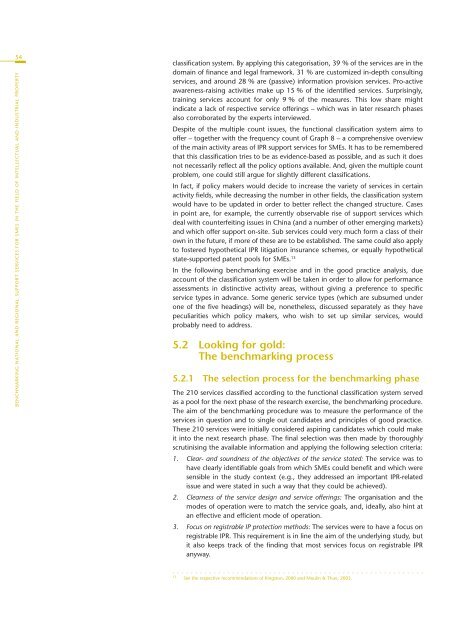Benchmarking National - PRO INNO Europe
Benchmarking National - PRO INNO Europe
Benchmarking National - PRO INNO Europe
Create successful ePaper yourself
Turn your PDF publications into a flip-book with our unique Google optimized e-Paper software.
54<br />
BENCHMARKING NATIONAL AND REGIONAL SUPPORT SERVICES FOR SMES IN THE FIELD OF INTELLECTUAL AND INDUSTRIAL <strong>PRO</strong>PERTY<br />
classification system. By applying this categorisation, 39 % of the services are in the<br />
domain of finance and legal framework. 31 % are customized in-depth consulting<br />
services, and around 28 % are (passive) information provision services. Pro-active<br />
awareness-raising activities make up 15 % of the identified services. Surprisingly,<br />
training services account for only 9 % of the measures. This low share might<br />
indicate a lack of respective service offerings – which was in later research phases<br />
also corroborated by the experts interviewed.<br />
Despite of the multiple count issues, the functional classification system aims to<br />
offer – together with the frequency count of Graph 8 – a comprehensive overview<br />
of the main activity areas of IPR support services for SMEs. It has to be remembered<br />
that this classification tries to be as evidence-based as possible, and as such it does<br />
not necessarily reflect all the policy options available. And, given the multiple count<br />
problem, one could still argue for slightly different classifications.<br />
In fact, if policy makers would decide to increase the variety of services in certain<br />
activity fields, while decreasing the number in other fields, the classification system<br />
would have to be updated in order to better reflect the changed structure. Cases<br />
in point are, for example, the currently observable rise of support services which<br />
deal with counterfeiting issues in China (and a number of other emerging markets)<br />
and which offer support on-site. Sub services could very much form a class of their<br />
own in the future, if more of these are to be established. The same could also apply<br />
to fostered hypothetical IPR litigation insurance schemes, or equally hypothetical<br />
state-supported patent pools for SMEs. 13<br />
In the following benchmarking exercise and in the good practice analysis, due<br />
account of the classification system will be taken in order to allow for performance<br />
assessments in distinctive activity areas, without giving a preference to specific<br />
service types in advance. Some generic service types (which are subsumed under<br />
one of the five headings) will be, nonetheless, discussed separately as they have<br />
peculiarities which policy makers, who wish to set up similar services, would<br />
probably need to address.<br />
5.2 Looking for gold:<br />
The benchmarking process<br />
5.2.1 The selection process for the benchmarking phase<br />
The 210 services classified according to the functional classification system served<br />
as a pool for the next phase of the research exercise, the benchmarking procedure.<br />
The aim of the benchmarking procedure was to measure the performance of the<br />
services in question and to single out candidates and principles of good practice.<br />
These 210 services were initially considered aspiring candidates which could make<br />
it into the next research phase. The final selection was then made by thoroughly<br />
scrutinising the available information and applying the following selection criteria:<br />
1. Clear- and soundness of the objectives of the service stated: The service was to<br />
have clearly identifiable goals from which SMEs could benefit and which were<br />
sensible in the study context (e.g., they addressed an important IPR-related<br />
issue and were stated in such a way that they could be achieved).<br />
2. Clearness of the service design and service offerings: The organisation and the<br />
modes of operation were to match the service goals, and, ideally, also hint at<br />
an effective and efficient mode of operation.<br />
3. Focus on registrable IP protection methods: The services were to have a focus on<br />
registrable IPR. This requirement is in line the aim of the underlying study, but<br />
it also keeps track of the finding that most services focus on registrable IPR<br />
anyway.<br />
13 See the respective recommendations of Kingston, 2000 and Moulin & Thue, 2005.
















